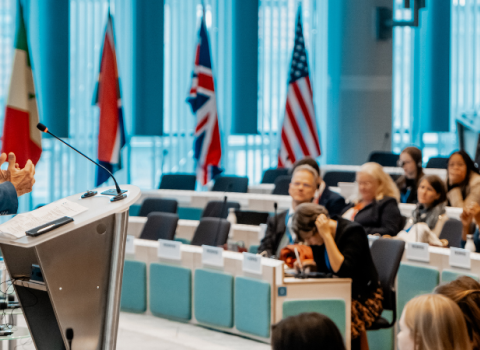The gas is looked to as a key to decarbonising Europe’s energy mix. To achieve massive roll-out by 2050, decisions on the future of green hydrogen must be taken now, policymakers say

Green hydrogen technologies are still in their infancy, but the EU will have to make important decisions on the future of the gas in its energy mix within the next few months, setting out a clear roadmap for creating and regulating the market in hydrogen, scaling-up innovations and agreeing a definition of ‘low-carbon’ hydrogen.
“2021 will be the year in which the EU and its member states take important decisions that will largely determine further deployment of hydrogen in our continent,” said Bas van 't Wout, Dutch minister of economic affairs and climate policy, speaking at conference on hydrogen organised by the Portuguese Council Presidency.
Hydrogen is seen as a critical component of greening Europe’s energy market and delivering on the aim of becoming the first carbon-neutral continent by 2050. While renewable electricity will lead the way, hydrogen is expected to replace natural gas in industries that cannot be easily electrified, such as steel production and aviation. In 2050, the gas could make up as much as 23% of the EU energy mix.
The problem is that most hydrogen today is grey rather than green. It is made by reforming natural gas, a process that releases large amounts of CO2 into the atmosphere. The EU hopes to build its future energy mix on green hydrogen produced through electrolysis, where electricity from a renewable source is passed through water to separate hydrogen and oxygen.
The European Commission presented the EU hydrogen strategy in July 2020, setting goals for the scale-up of renewable hydrogen technology and calling for €470 billion in investments for the next thirty years. By 2030, the Commission hopes to have 40GW of electrolysers in the EU, producing up to 10 million tonnes of renewable hydrogen each year.
As with other renewable fuels, there is a cost barrier to get over, in that currently electrolysers are costly and not efficient enough to power a competitive hydrogen economy. To bring the technology to the market, the EU needs to make major investments in research and innovation.
Europe is not alone in looking to capitalise on hydrogen as a green energy source. In January, Canada launched the world’s largest green hydrogen plant, while in November Chile presented plans to produce the world’s cheapest green hydrogen by 2030.
“Hydrogen has a high global potential. It has a global profile, and it is basically the flavour of the month,” said Anna Krzyzanowska, advisor at the European Commission to the Mission Innovation Steering Committee, a global intergovernmental initiative working to accelerate clean energy innovation.
This has both good and bad implications for Europe. The good, Krzyzanowska says, is that more money will be invested in green hydrogen to reach the technology tipping point. The bad is that Europe must act quickly and not waste any time to secure its share of the pie and step-up global collaboration.
But to act, the EU still needs a how-to. Last December, member states asked the Commission “to further elaborate and operationalise” the EU hydrogen strategy, outlining a pathway for reaching the goal of having 40GW of electrolysers by 2030.
Member state priorities
EU member states will next discuss the future of hydrogen in June. But while more and more member states are launching their own hydrogen strategies and coordinating joint projects, they do not see eye to eye on some key issues, such as what counts as ‘low-carbon’ hydrogen.
The Netherlands, for one, supports using fossil fuel-derived hydrogen during the transition period to renewable hydrogen. Storing the CO2 emitted in the process instead of releasing it into the atmosphere produces blue hydrogen, an arguably low-carbon alternative to green hydrogen. Some countries believe it should be used to build up a hydrogen economy while green hydrogen costs remain high.
But countries hoping to export the green gas want to go directly to producing hydrogen from water using electricity from renewable sources. “We are only one or two investment cycles away from 2050. It’s more critical than ever to avoid investments and policy decisions which may lock us into fossil dependence or become stranded assets,” said Sara Aagesen Muñoz, Spain’s secretary of state for energy.
In the end, it comes down to different national strategies. The Netherlands does not have the renewable electricity capacity to become a major hydrogen producer and is focusing instead on creating the infrastructure. “One of the main aims [of our strategy] is the development of a hydrogen backbone by repurposing part of our gas infrastructure,” said van 't Wout. “With this backbone, we will be able to connect the major industrial clusters in the Netherlands and possibly in north western Europe to multiple hydrogen sources.”
Spain, on the other hand, has rich renewable energy resources, and prioritises scaling up electrolyser technology, adapting industrial processes to green hydrogen and exploring the potential of storing hydrogen in its plan, which foresees a €1.5 billion investment from the EU pandemic recovery fund.
Claude Turmes, Luxembourg’s energy minister, in support of green hydrogen, suggested carrying out a review of the EU Emission Trading System, to ensure it stimulates the move from fossil to renewable hydrogen.
In the end, investing in electrolysers is “the most important question for the future of hydrogen,” said Turmes. Investing in blue hydrogen does not help the cause, he added.
Electrolyser capacity
Alongside member state initiatives, the Commission is deploying a number of tools to bring the hydrogen economy to life.
In Horizon Europe, the EU’s research programme, seven public-private partnerships will work on technology for the hydrogen economy.
With an EU contribution of €1 billion matched by industry money, the Clean Hydrogen Partnership for Europe will develop technology for producing, distributing and storing clean hydrogen. The partnership is a continuation of a previous 12-year initiative between the Commission and the industry, which boosted electrolyser capacity from 0.15MW in 2011 to 100MW in 2021. The regulation for the new partnership is currently in the hands of the member states. Once it is settled, the Commission hopes to launch it by the end of the year.
Six other Horizon Europe initiatives will focus on decarbonising rail, aviation and steel, among other sectors, developing hydrogen-powered alternatives in the next seven years.
Scale-up will require synergies between different programmes. Here, member states hope the European Research Area (ERA) will help catalyse innovation.
Last year, member states renewed their commitment to creating a common European market for research, after the failed first attempt initiated 20 years ago. Now, they hope it can enable hydrogen innovation through partnerships and joint investments, according to December Council conclusions.
In December, member states also launched an “Important Project of Common European Interest” for hydrogen, a legal framework for big cross-border projects, which allows member states to coordinate and fund innovation in the hydrogen value chain.
Christian Holzleitner, head of unit for land use and finance for innovation at the Commission, says Europe already knows how to get to its final destination. “The challenge that we have is to up-scale all of these technologies and to put them on the market,” he said.
Here, money is needed. While technologies for producing hydrogen are still significantly more expensive than fossil fuel, the EU is ready to help level the playing field. In the next decade, the European Investment Bank can provide enough financing to cover 60% of the gap in pricing between fossil fuel and hydrogen technologies, Holzleitner said.
But for once, the money does not seem to be the main issue. Right now, “setting a clear vision is key,“ said EU energy commissioner, Kadri Simson.





 A unique international forum for public research organisations and companies to connect their external engagement with strategic interests around their R&D system.
A unique international forum for public research organisations and companies to connect their external engagement with strategic interests around their R&D system.